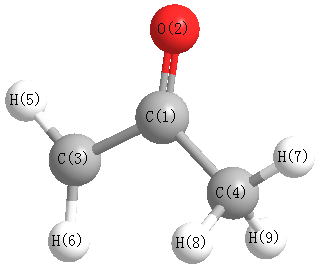Vibrational Frequencies calculated at MP2/aug-cc-pVDZ
| Mode Number |
Symmetry |
Frequency
(cm-1) |
Scaled Frequency
(cm-1) |
IR Intensities
(km mol-1) |
Raman Act
(Å4/u) |
Dep P |
Dep U |
|---|
| 1 |
A' |
3337 |
3200 |
2.48 |
|
|
|
| 2 |
A' |
3214 |
3082 |
7.06 |
|
|
|
| 3 |
A' |
3199 |
3068 |
0.41 |
|
|
|
| 4 |
A' |
3069 |
2943 |
0.46 |
|
|
|
| 5 |
A' |
2091 |
2005 |
1173.87 |
|
|
|
| 6 |
A' |
1467 |
1407 |
25.33 |
|
|
|
| 7 |
A' |
1449 |
1389 |
24.60 |
|
|
|
| 8 |
A' |
1376 |
1319 |
52.05 |
|
|
|
| 9 |
A' |
1263 |
1211 |
82.47 |
|
|
|
| 10 |
A' |
1068 |
1024 |
7.55 |
|
|
|
| 11 |
A' |
893 |
856 |
15.08 |
|
|
|
| 12 |
A' |
823 |
790 |
1.82 |
|
|
|
| 13 |
A' |
528 |
506 |
16.84 |
|
|
|
| 14 |
A' |
379 |
364 |
2.30 |
|
|
|
| 15 |
A" |
3157 |
3028 |
4.60 |
|
|
|
| 16 |
A" |
1467 |
1407 |
8.10 |
|
|
|
| 17 |
A" |
1032 |
990 |
8.64 |
|
|
|
| 18 |
A" |
686 |
658 |
34.69 |
|
|
|
| 19 |
A" |
525 |
503 |
1.39 |
|
|
|
| 20 |
A" |
257 |
246 |
0.00 |
|
|
|
| 21 |
A" |
115 |
110 |
0.13 |
|
|
|
Unscaled Zero Point Vibrational Energy (zpe) 15697.2 cm
-1
Scaled (by 0.959) Zero Point Vibrational Energy (zpe) 15053.6 cm
-1
See section
III.C.1 List or set vibrational scaling factors
to change the scale factors used here.
See section
III.C.2
Calculate a vibrational scaling factor for a given set of molecules
to determine the least squares best scaling factor.
